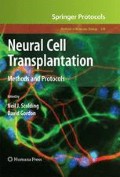Summary
A useful experimental model to study the pathophysiology of cerebral ischemia without craniectomy is the middle cerebral artery occlusion (MCAO) model. In this model, an intraluminal suture is advanced from the internal carotid artery to occlude the base of the MCA. Standardized procedures in terms of suture size, animal weight, and the details of intraluminal suture insertion are well established. This procedure can produce reversible occlusion after insertion of the intraluminal suture for a specified period of time, or a permanent occlusion by leaving the suture in place. This model has been useful in the study of both the normal pathophysiology of cerebral ischemia and in assessing interventional therapeutic approaches for stroke therapy. One approach has been the intravenous delivery of bone marrow-derived mescenchymal stem cells at various times after MCAO. Histological and magnetic resonance imaging have been used to quantify infarction volume in this model system.
Access this chapter
Tax calculation will be finalised at checkout
Purchases are for personal use only
References
Eklof B, Siesjo BK (1972) The effect of bilateral carotid artery ligation upon acid-base parameters and substrate levels in the rat brain. Acta Physiol Scand;86(4):528–38.
Salford LG, Plum F, Brierley JB (1973) Graded hypoxia-oligemia in rat brain. II. Neuropathological alterations and their implications. Arch Neurol;29(4):234–8.
Longa EZ, Weinstein PR, Carlson S, Cummins R (1989) Reversible middle cerebral artery occlusion without craniectomy in rats. Stroke;20: 84–91.
Garcia JH, Yoshida Y, Chen H, Li Y, Zhang ZG, Lian J, Chen S, Chopp M (1993) Progression from ischemic injury to infarct following middle cerebral artery occlusion in the rat. Am J Pathol;142:623–35.
Li Y, Sharov VG, Jiang N, Zaloga C, Sabbah HN, Chopp M (1995) Ultrastructural and light microscopic evidence of apoptosis after middle cerebral artery occlusion in the rat. Am J Pathol;146:1045–51.
Schaffer CB, Friedman B, Nishimura N, Schroeder LF, Tsai PS, Ebner FF, Lyden PD, Kleinfeld D (2006) Two-photon imaging of cortical surface microvessels reveals a robust redistribution in blood flow after vascular occlusion. PLoS Biol;4(2):e22.
Sun Y, Jin K, Xie L, Childs J, Mao XO, Logvinova A, Greenberg DA (2003) VEGF-induced neuroprotection, neurogenesis, and angiogenesis after focal cerebral ischemia. J Clin Invest;111(12):1843–51.
Ito D, Walker JR, Thompson CS, Moroz I, Lin W, Veselits ML, Hakim AM, Fienberg AA, Thinakaran G (2004) Characterization of stanniocalcin 2, a novel target of the mammalian unfolded protein response with cytoprotective properties. Mol Cell Biol;24(21):9456–69.
Chopp M, Li Y (2002) Treatment of neural injury with marrow stromal cells. Lancet Neurol;1(2):92–100.
Shen LH, Li Y, Chen J, Cui Y, Zhang C, Kapke A, Lu M, Savant-Bhonsale S, Chopp M (2007) One-year follow-up after bone marrow stromal cell treatment in middle-aged female rats with stroke. Stroke;38:2150–6.
Iihoshi S, Honmou O, Houkin K, Hashi K, Kocsis JD (2004) A therapeutic window for intravenous administration of autologous bone marrow after cerebral ischemia in adult rats. Brain Res;1007:1–9.
Nomura T, Honmou O, Harada K, Houkin K, Hamada H, Kocsis JD (2005) I.V. infusion of brain-derived neurotrophic factor gene-modified human mesenchymal stem cells protects against injury in a cerebral ischemia model in adult rat. Neuroscience;136:161–9.
Honma T, Honmou O, Iihoshi S, Harada K, Houkin K, Hamada H, Kocsis JD (2006) Intravenous infusion of immortalized human mesenchymal stem cells protects against injury in a cerebral ischemia model in adult rat. Exp Neurol;199(1):56–66.
Li Y, Chen J, Wang L, Lu M, Chopp M (2001) Treatment of stroke in rat with intracarotid administration of marrow stromal cells. Neurology;56:1666–72.
Kurozumi K, Nakamura K, Tamiya T, Kawano Y, Kobune M, Hirai S, et al (2004) BDNF gene-modified mesenchymal stem cells promote functional recovery and reduce infarct size in the rat middle cerebral artery occlusion model. Mol Ther;9:189–97.
Hamada H, Kobune M, Nakamura K, Kawano Y, Kato K, Honmou O, Houkin K, Matsunaga T, Niitsu Y (2005) Mesenchymal stem cells (MSC) as therapeutic cytoreagents for gene therapy. Cancer Sci;96(3):149–56.
Mahmood A, Lu D, Wang L, Chopp M (2002) Intracerebral transplantation of marrow stromal cells cultured with neurotrophic factors promotes functional recovery in adult rats subjected to traumatic brain injury. J Neurotrauma;19(12):1609–17.
Liu H, Honmou O, Harada K, Nakamura K, Houkin K, Hamada H, Kocsis JD (2006) Neuroprotection by PlGF gene-modified human mesenchymal stem cells after cerebral ischaemia. Brain;129(Pt 10):2734–45.
Horita Y, Honmou O, Harada K, Houkin K, Hamada H, Kocsis JD (2006) Intravenous administration of glial cell line-derived neurotrophic factor gene-modified human mesenchymal stem cells protects against injury in a cerebral ischemia model in the adult rat. J Neurosci Res;84(7):1495–504.
Ukai R, Honmou O, Harada K, Houkin K, Hamada H, Kocsis JD (2007) Mesenchymal stem cells derived from peripheral blood protects against ischemia. J Neurotrauma;24(3):508–20.
Acknowledgments
This work was supported in part by the Medical and Rehabilitation and Development Research Services of Department of Veterans Affairs, the National Institutes of Health (NS43432), and the National Multiple Sclerosis Society (RG2135; CA1009A10), the Paralyzed Veterans of America Research Foundation (2469), the Japanese Ministry of Education, Science, Sports and Culture (16390414), Mitsui Sumitomo Insurance Welfare Foundation, JST (Japan, Science and Technology Corporation) Innovation Plaza Hokkaido Project. The Center for Neuroscience and Regeneration Research is a collaboration of the Paralyzed Veterans of America and the United Spinal Association with Yale University.
Author information
Authors and Affiliations
Corresponding author
Editor information
Editors and Affiliations
Rights and permissions
Copyright information
© 2009 Humana Press, a part of Springer Science+Business Media, LLC
About this protocol
Cite this protocol
Sasaki, M., Honmou, O., Kocsis, J.D. (2009). A Rat Middle Cerebral Artery Occlusion Model and Intravenous Cellular Delivery. In: Gordon, D., Scolding, N. (eds) Neural Cell Transplantation. Methods in Molecular Biology™, vol 549. Humana Press, Totowa, NJ. https://doi.org/10.1007/978-1-60327-931-4_13
Download citation
DOI: https://doi.org/10.1007/978-1-60327-931-4_13
Published:
Publisher Name: Humana Press, Totowa, NJ
Print ISBN: 978-1-60327-930-7
Online ISBN: 978-1-60327-931-4
eBook Packages: Springer Protocols

